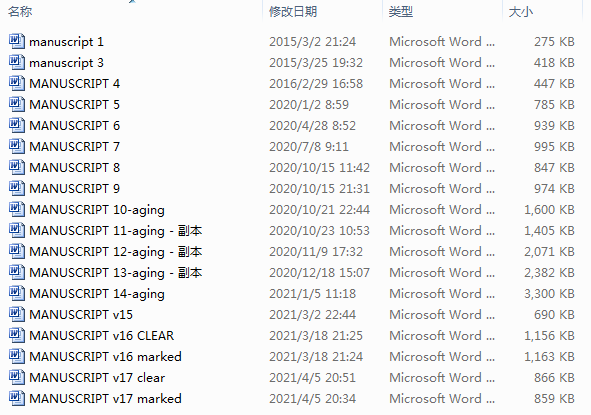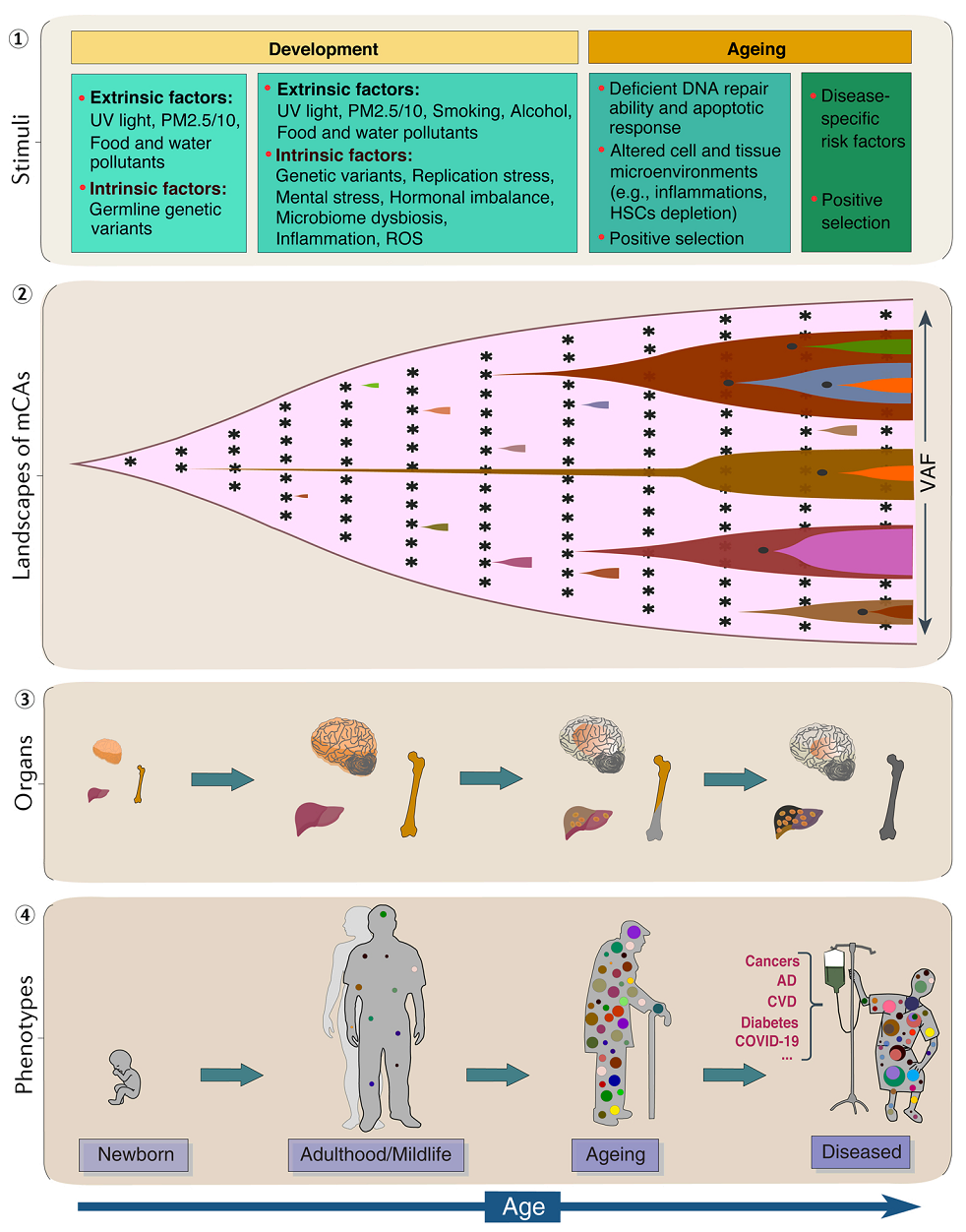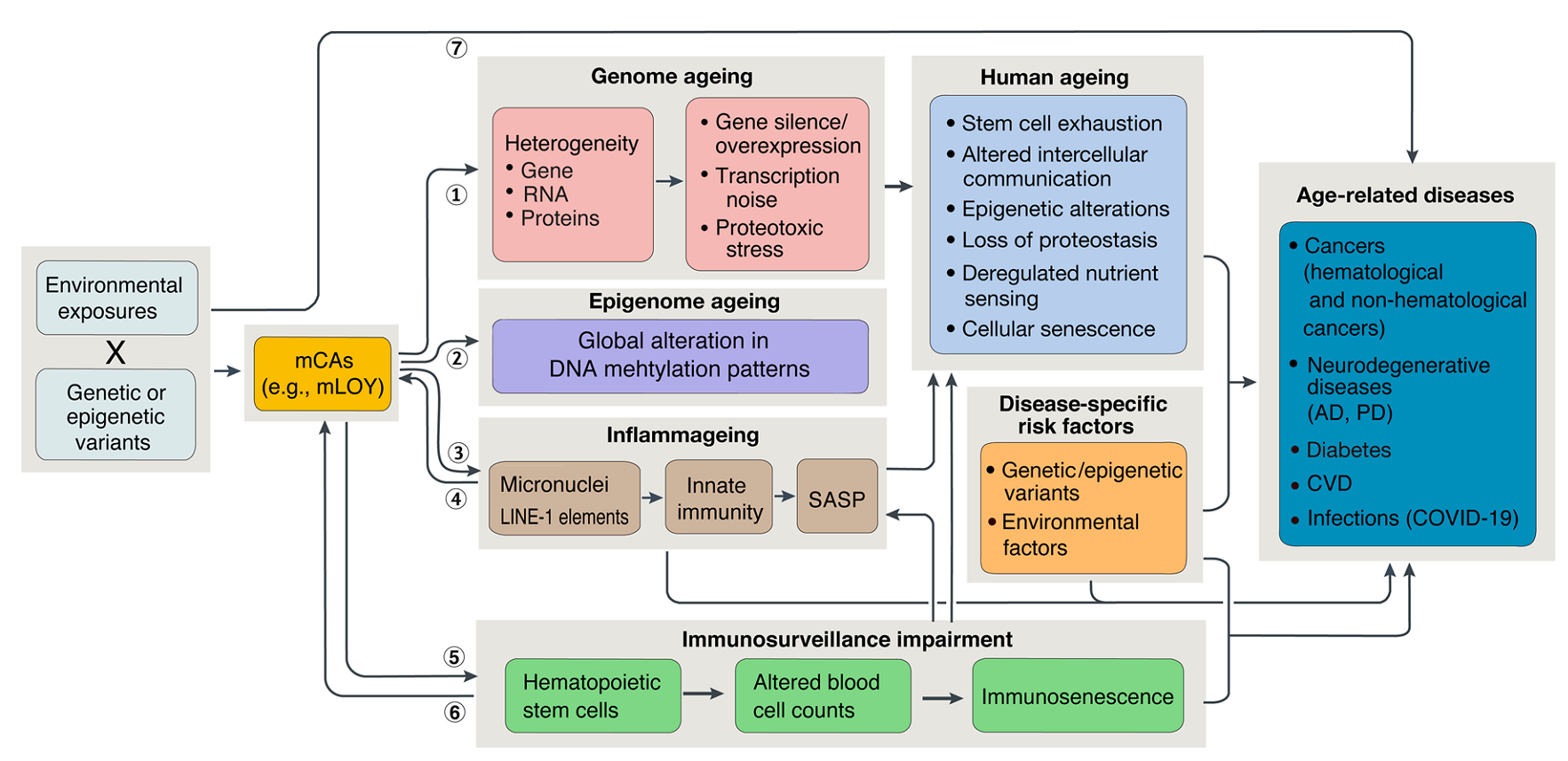博文
记学术生涯中的首篇10+论文
 精选
精选
|
2021年4月15日,学术生涯中的首篇10+论文《Decoding and rejuvenating human ageing genomes: Lessons from mosaic chromosomal alterations》终于被Ageing Research Reviews (CiteScore: 18.9; Impact Factor: 10.616 )接受发表了。

(全文见:https://www.sciencedirect.com/science/article/pii/S1568163721000891#!)
该论文系统性、多维度地阐述了人体衰老基因组中普遍存在的嵌合性染色体畸变(mosaic chromosomal alterations, mCAs)现象,从人群分布情况、发生机制、相关基因突变和环境诱发因素、及其生理/病理作用,到预防mCAs的潜在手段。随着基因组测序成本的降低,全球各地针对十万人以上规模的Biobanks,如UK Biobank(>50万人)和Biobank Japan(>20万人),进行单基因组测序的研究越来越多。其中,一个重大发现是,在不同种族的人群中,mCAs在衰老个体血细胞基因组中的发生率显著上升,表明衰老个体中的克隆性造血(clonal hematopoiesis)推动了mCAs的上升。关键的是,mCAs与众多衰老相关疾病,如肿瘤、阿尔茨海默症、糖尿病和心血管疾病,甚至新冠肺炎(COVID-19),的风险显著相关。这个发现可能会推动生物学家重新审视人类健康和疾病发生的概念,也暗示mCAs可能是驱动个体衰老以及衰老相关疾病风险甚至发生和发展的重要因素之一。mCAs对衰老研究的另一个重要性体现在:之前科学家对衰老的认知基本依赖动物模型,真正发生在人体细胞和分子层面的情况大都未知;而mCAs发现于大规模人群基因组中,对研究人类衰老具有更直接的现实意义。因此,可以推测从mCAs方面解码人类衰老基因组对于今后人类衰老的研究,衰老相关疾病风险评估、以及抗个体/基因组衰老的药物/干预手段研发具有很强的指导意义。

虽然本文从投稿到接受很顺利,只用了3个月的时间。但是,中间的过程,从构思,阅读海量文献,到反复修订,前后共计花了6年时间(2014年12月-2021年1月)。全文总计31页,正文接近2万字,包含8张图和2张表。所以,这篇文章的顺利接受给我最大的启发是机会是留给准备充分的人。


本文在投稿Ageing Research Reviews之前还有个插曲,我斗胆给Trends in Genetics主编写了Presubmission Inquiries。当然,Trends in Genetics大部分综述都是约稿,所以不出意外,本文被主编很客气地回绝了。这个高峰就只有后面再去攀登了。另外,2020年我将mCAs中最受关注的嵌合性Y染色体丢失(mosaic loss of Y chromosome)单独整理成文,以Mosaic loss of human Y chromosome: what, how and why为题发表在Human Genetics上(https://link.springer.com/article/10.1007/s00439-020-02114-w)。

言归正传,本文的审稿人总共3位,其中之一是Po-Ru Loh。Po-Ru Loh是美国哈佛大学医学院统计遗传学和生物信息学领域的大牛,青年才俊。他基于UK Biobank的两项mCAs研究成果,分别于2018年和2020年发表于Nature上(https://www.nature.com/articles/s41586-018-0321-x;https://www.nature.com/articles/s41586-020-2430-6)。同时,Loh还开发了用于mCAs分析的软件Mosaic Chromosomal Alterations software (MoChA),现已对学术界开放,可免费使用(https://github.com/freeseek/mocha)。从长相和名字推断Loh应该是东南亚华裔。谷歌学术画像显示其总被引 14,777,H-index 43。他给我的论文的评价很高:
I want to commend the authors for writing a great review article. The authors have addressed all of my concerns and they have truly performed an incredibly extensive job summarizing a large amount of literature related to mCAs on very different topics. This review is going to be a great entry point for researchers and physicians who want to better understand the field of somaticism driven by mosaic chromosomal alterations.
另外一位审稿人是日本RIKEN Center for Integrative Medical Sciences的Chikashi Terao。2020年Terao和Loh在Nature背靠背发表了关于Biobank Japan中mCAs的研究论文(https://www.nature.com/articles/s41586-020-2426-2)。Terao对本文章的评价也还蛮中肯的:
This review by X. Dai and X. Guo is a very interesting and deep revision of the emergent field of mosaic chromosomal alterations (mCAs) and their impact in age-related diseases. Although clonal mosaicism has become a prevalent feature of aging genomes in recent years, a comprehensive and focused analysis on mCAs has been missing beyond the clonal hematopoiesis. Here, the authors provide an extended view of the causes and consequences of mCAs in aging-associated diseases. Importantly, mechanisms behind the association between mCAs and diseases, as well as strategies to rejuvenate mCAs and extend healthspan are discussed.
我的直接感受是:文章被这样的两位业内大牛审稿,真的会学到非常多的知识,开拓自己的眼界。他们会把自己的新的想法在审稿过程中以Comments的形式全部无私地给出来,让我们直接加到文中进行讨论。他们的Nature文章我们反复看了数十遍,但还是会漏掉很多细节,或者对一些内容不是很理解。他们的Comments能让我们有一种茅塞顿开的感觉。所以,大家在投文章推荐审稿人时,不要害怕推荐大牛,因为如果文章有幸被他们审稿,真的会让文章有质的飞跃。
第三位审稿人给的意见较少,评论一般:
Guo et al, reviewed mosaic chromosomal alterations (mCA), aka CHIP (clonal hematopoiesis of indeterminate potentia), in a comprehensive manner in this paper. This paper is basically well written and the authors made nice efforts to capture mCA in multiple aspects.
这篇文章另一个煞费心血的方面就是制图。作为综述文章,编辑和读者可能更看重Figure和Table是否能够体现出对主题内容的综合呈现。全文总计8张Figures,线条图案和色彩搭配的细节经过反复打磨。

Figure 1. Mosaicism and ageing genomes.

Figure 2. Key findings for the relationship between detectable mCAs and human ageing.

Figure 3. A schematical depiction of the dynamic nature, causes and consequences of somatic mCAs throughout a human's lifespan.

Figure 4. The landscapes of detectable mCAs in human ageing genomes.

Figure 5. Overview of the diverse mechanisms enabling mCA generation and propagation.

Figure 6. Schematic illustration of how mCAs contribute to human ageing and age-related diseases.

Figure 7. Strategies to rejuvenate ageing genomes for extending human healthspan and lifespan.

Figure 8. Detectable mCAs in extremely long-lived individuals: from characteristics to implications.
文章的最后我特别感谢我的外婆。外婆把我从小抚养大,遗憾的是,她却没有享受到我的丝毫回报,于2016年年底去世,享年86岁。这篇文章的构思正是2014年春节,也是我和外婆过的最后一个春节。因此,谨以此文献给我敬爱的外婆!感谢她从小养育了我,用她的点点滴滴感染着我,传递和培养了我坚韧不拔、吃苦耐劳的性格,成为了我一生中最宝贵的财富!

另外,感谢国家基金委(31900140),云南省科技厅(202001AU070055)和云南师范大学优秀青年学者培育项目对我各项研究的支持!
https://blog.sciencenet.cn/blog-419182-1285413.html
上一篇:To: Angelika Amon (1967-2020)
下一篇:零报酬又匿名,我们为什么热爱当审稿人